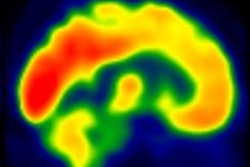
Researchers using FDG-PET have uncovered healthy patterns of glucose metabolism in the brains of people at risk for Alzheimer's disease who consistently partake in moderate-intensity physical activity, according to a study published online June 22 in the Journal of Alzheimer's Disease.
The group from the University of Wisconsin-Madison used accelerometers to measure the daily physical activity of 93 late-middle-age subjects at high genetic risk for Alzheimer's in the Wisconsin Registry for Alzheimer's Prevention (WRAP). One key study prerequisite was that the subjects showed no cognitive impairment.
 People at risk for Alzheimer's disease who do more moderate-intensity physical activity -- but not light-intensity activity -- are more likely to have healthy patterns of glucose metabolism in their brain. Image courtesy of the University of Wisconsin-Madison.
People at risk for Alzheimer's disease who do more moderate-intensity physical activity -- but not light-intensity activity -- are more likely to have healthy patterns of glucose metabolism in their brain. Image courtesy of the University of Wisconsin-Madison.Senior author Ozioma Okonkwo, PhD, and colleagues determined that moderate physical activity, which is equivalent to a brisk walk, was associated with greater levels of glucose metabolism in all brain regions viewed on FDG-PET. In addition, subjects who spent at least 68 minutes per day engaged in moderate physical activity showed better glucose metabolism profiles than those who spent less time.
Ongoing research is focused on better elucidating the neuroprotective effect of exercise against Alzheimer's disease, Okonkwo said. The researchers are recruiting subjects concerned about their memory for a national clinical trial to test whether physical exercise can slow the progression of early memory problems caused by Alzheimer's disease.



















